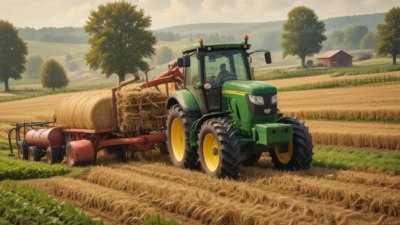How Farmers and Gardeners Adjust Routines as Seasons Turn
Explore how farmers and gardeners adapt their routines to changing seasons, enhancing productivity and sustainability.

This image was created with the assistance of Freepik
As the seasons turn, the routines of farmers and gardeners undergo significant adjustments to keep pace with nature's rhythms. Understanding these transitions is vital for optimizing productivity and sustainability. Whether it's the plant selection, watering techniques, or pest management, each season brings unique challenges and opportunities.
Farmers typically start planning their crop rotations during the initial stages of spring. This phase is crucial for preparing the land, selecting the right seeds, and ensuring they take full advantage of the growing season. Within the agricultural community, this period is marked by intense activity, including soil preparation, planting, and irrigation setup. Gardeners, albeit on a smaller scale, also engage in similar tasks, starting with sowing seeds indoors or in greenhouses to nurture seedlings before transplanting them into gardens.
Spring: Planting Season
The arrival of spring stirs budding energy among farmers and gardeners alike. This time is marked by increased daylight hours and warmer temperatures, which signal the need to plant crops. Farmers often prepare their fields by tilling the soil, adjusting pH levels, and applying organic matter to enhance fertility. Selecting the right crops is paramount in this season; popular choices for early planting include peas, lettuce, and radishes which are cold-resistant. For gardeners, starting herbs, tomatoes, and peppers indoors can offer a head start.
As the warmth of spring envelops the landscape, watering becomes crucial. Farmers may adjust their irrigation systems to ensure even moisture distribution, critical for seed germination. Drip irrigation is commonly preferred for its efficiency and effectiveness, particularly during this period to prevent fungal diseases that excess moisture can encourage. Gardeners similarly have to monitor their plants closely, learning to recognize signs of water stress to maintain healthy growth.
Summer: Maintenance and Growth
When summer approaches, the focus shifts towards maintenance and growth management. The long days allow crops to flourish, but they also demand more from farmers and gardeners in terms of management. This season involves regular monitoring for pests and diseases, which can become rampant under the right conditions. Farmers may deploy integrated pest management strategies that include crop rotation, beneficial insects, and organic sprays to mitigate risks. For gardeners, keeping a close eye on their plants’ health and employing companion planting can yield better results.
Moreover, summer is a time of abundance—harvesting becomes the primary focus. Farmers must adjust their routines to accommodate the soaring demands of harvest while ensuring timely distribution. This hands-on stage calls for long hours in the fields, emphasizing the need for effective labor management. Gardeners, too, are rewarded during this season as homegrown produce becomes available, prompting harvesting and preservation activities like canning, freezing, and drying.
Autumn: Preparation for Winter
As autumn approaches, routines start shifting once more in preparation for winter. For farmers, this is the season to harvest late crops like squash, pumpkins, and other root vegetables, which are often left to mature until the cooler months. The act of harvesting requires careful strategies to avoid damage to crops, and often involves long days. Post-harvest, farmers must consider storage solutions, determining whether to root cellar or glaze their crops based on their characteristics.
Gardeners, observing similar cues, begin clearing their plots, removing dead plant material to reduce disease risk, and preparing their soil for the upcoming season. Cover crops are often a strategy implemented to enhance soil health and prevent erosion during the winter months. Moreover, autumn is a good time for planting perennials and certain bulbs such as tulips and daffodils to ensure a vibrant garden come springtime.
Winter: Rest and Planning
Come winter, the activity slows down significantly. For farmers, this is traditionally viewed as a period of rest, though it does not equate to inactivity. During the colder months, farmers shift their focus toward planning for the upcoming growing season. This involves evaluating past seasons’ successes and failures, budgeting for seeds and supplies, and sometimes attending workshops and agricultural fairs to learn about new techniques or innovations in the industry.
Gardeners take on a similar approach during winter. Many engage in research and planning, looking through seed catalogs and deciding on next year’s varieties. This also presents an opportune moment for gardeners to organize their tools and equipment, ensuring everything is in working order for when spring arrives. Winter can also be a time to practice indoor gardening or create a small greenhouse enthusiastically nurturing plants that flourish indoors.
Seasonal Adjustment Strategies
Throughout these seasonal transitions, both farmers and gardeners employ various strategies to adapt to changing conditions. The application of modern technology has been pivotal; farmers may utilize soil moisture sensors, weather forecasting tools, and crop management software to optimize their routines. Such technologies allow for precise adjustments based on real-time data and can lead to improved efficiency and sustainability.
In contrast, many gardeners benefit from community knowledge and sharing resources. Joining local gardening clubs or participating in community garden initiatives often leads to a wealth of shared experiences and may introduce novel techniques or hybrid varieties that can work well in specific climates. This collective knowledge sharing acts as a lifeline, fostering resilience against the changing seasons.
Embracing Change
Ultimately, the ability to embrace change as seasons turn is what defines successful farmers and gardeners. Adaptability is not just a theme throughout the year; it is an essential mindset. This journey reflects a deep connection to the land and an understanding of the environment's inherent rhythms—one that prompts cultivated mindfulness and respect for natural processes.
By honoring seasonal changes, farmers and gardeners alike forge a sustainable path toward agricultural practices that can endure the test of time while producing nourishing food for communities. As the seasons inevitably shift, so too can routines evolve, ensuring that the bond between human and nature continues to thrive.











